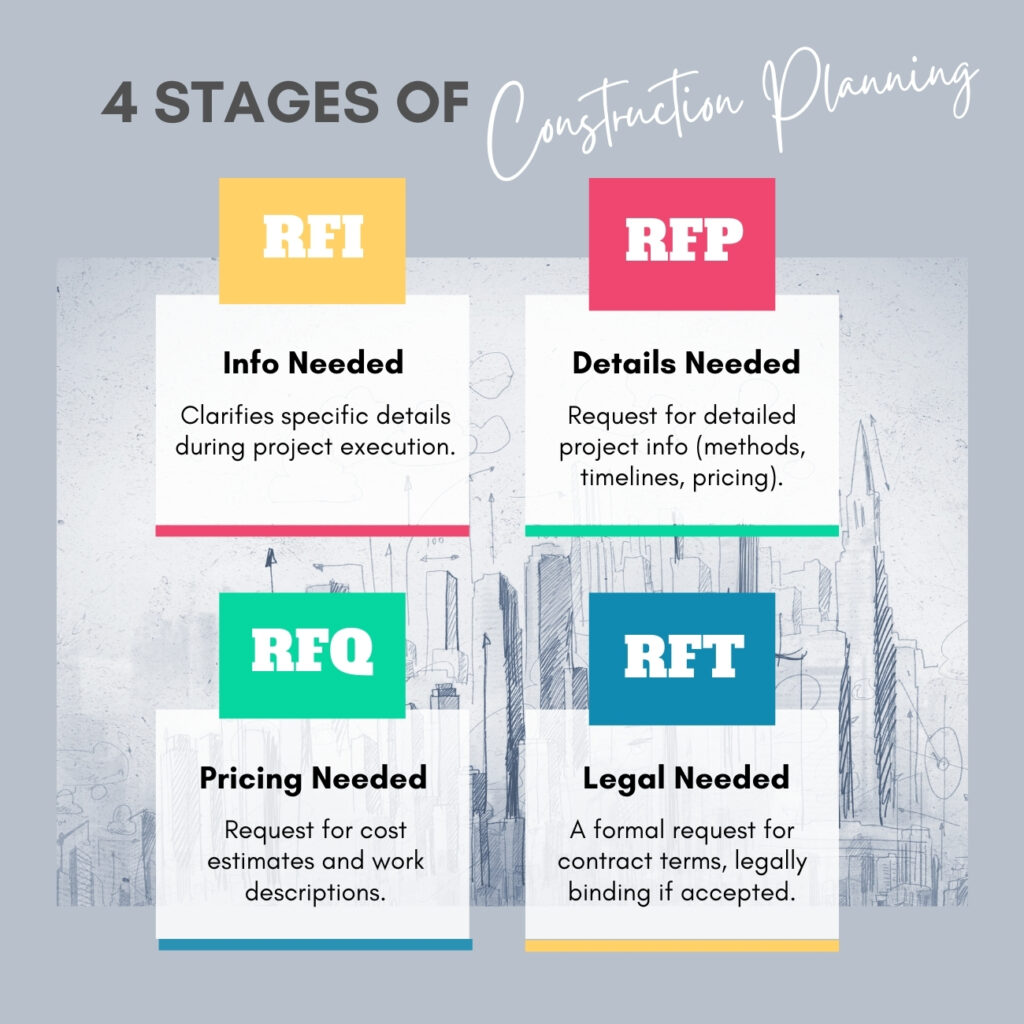The construction industry, with its complex projects and myriad of stakeholders, relies heavily on clear communication and detailed planning. One critical aspect of this communication is the Request for Information (RFI) process. RFIs in construction are formal questions submitted by a project participant to solicit an answer or clarification on any uncertainties within project documents, drawings, specifications, or other project-related conditions.
The Purpose of RFIs in Construction
RFIs serve multiple purposes in a construction project. Primarily, they are used to fill information gaps, resolve ambiguities, and ensure that all parties have a clear understanding of the project requirements. This process helps to avoid costly mistakes and delays that can occur when issues are not addressed promptly.
RFIs are indispensable for avoiding misinterpretations, and streamlining communication between contractors, subcontractors, architects, engineers, and clients.
They may also serve as a contractual obligation to notify errors, conflicts, or omissions in project documentation.
Types of RFIs
- Design RFI: Requests regarding design discrepancies or missing details.
- Substitution RFI: When alternate materials or methods are proposed.
- Feasibility RFI: Questions related to project feasibility based on initial plans.
- Change RFI: Requests to alter part of the design, scope, or specifications.
- Resource Scheduling RFI: Adjustments to project timelines.
- Incomplete Specifications RFI: For gaps in technical requirements or standards.
- Construction Site RFI: Coordination-related questions, such as safety or scheduling issues.
The RFI Process
The RFI process typically begins when a contractor or subcontractor identifies a need for clarification. This need could arise from discrepancies in the project plans, lack of detail on certain specifications, or unforeseen site conditions that affect the original design. The RFI is then submitted to the design team, engineering, or other relevant professionals who can provide the necessary information.
When to Use RFIs
- Design Clarification: Missing or conflicting specifications in drawings.
- Scope Change: Alterations in project requirements.
- Substitution Requests: Changes in materials due to availability or cost.
- Unclear Specifications: Ambiguous terms or standards.
Components of an Effective RFI
A well-constructed RFI should be clear, concise, and contain all relevant information to facilitate a quick response. This usually includes:
-
- RFI Number & Title: For tracking purposes.
- Project Information: Name, location, and relevant details.
- Description of Issue: Clear and concise question or information request.
- Requested Action/Information: What exactly is needed.
- Attachments: Drawings, specifications, or other documents relevant to the request.
- Submission & Response Dates: Importance of deadlines for maintaining project timelines.
- Addresser & Recipient Details: Contact information for both parties.
Challenges in the RFI Process
One of the biggest challenges in managing RFIs is the time it takes to receive a response. Delays in the RFI process can lead to project slowdowns, increased costs, and frustration among team members. To mitigate these issues, it’s crucial to have a streamlined process for submitting and responding to RFIs.
Best Practices for Managing RFIs
Managing Requests for Information (RFIs) in construction is crucial for maintaining project clarity and efficiency. Here are some best practices to ensure effective RFI management:
1. Establish a Clear Process: Define a standardized procedure for submitting, reviewing, and responding to RFIs. This should include specific forms, timelines, and designated personnel responsible for each stage.
2. Use Technology: Implement RFI management software or tools that streamline the process. These platforms can help track submissions, responses, and any associated documentation, reducing the risk of miscommunication.
3. Encourage Timely Submissions: Set deadlines for RFI submissions to prevent delays in the project timeline. Communicate these deadlines clearly to all stakeholders involved in the construction process.
4. Provide Detailed Responses: When responding to RFIs, ensure that answers are comprehensive and address all aspects of the inquiry. This helps avoid further confusion and minimizes follow-up questions.
5. Document Everything: Keep thorough records of all RFIs submitted and their corresponding responses. This documentation is essential for future reference and can be invaluable during disputes or audits.
6. Train Your Team: Educate your team about the importance of RFIs in construction projects and how to manage them effectively. Regular training sessions can enhance understanding and improve overall communication among team members.
By following these best practices, construction teams can effectively manage RFIs, leading to smoother project execution and better collaboration among all parties involved.
The Impact of RFIs in Construction Projects
RFIs can significantly impact the cost and duration of construction projects. Research indicates that an average project might experience 15 to 20 RFIs per $1 million in project value, which can translate to substantial costs. Therefore, efficient management of the RFI process is essential for the successful delivery of construction projects.
The Difference Between RFI, RFP, RFQ, and RFT
The terms RFI, RFP, RFQ, and RFT are acronyms used in procurement and represent different stages of the sourcing process.
- An RFI, or Request for Information, is used to gather general information from potential suppliers and assess their capabilities and suitability for a project. It’s typically non-binding and exploratory.
- An RFP, or Request for Proposal, is more detailed and asks vendors to propose how they will solve a problem or fulfill the requirements of a project, often requiring creative solutions.
- An RFQ, or Request for Quotation, is used when the requirements are well-defined and the buyer is seeking detailed pricing information for comparison.
- An RFT, or Request for Tender, is a formal invitation to suppliers to bid on providing goods or services, often used in public sector procurement where transparency and fairness are paramount. Each of these tools serves a specific purpose in the procurement cycle, helping organizations to identify and select the most suitable vendors for their needs.

The Benefits of RFIs
The use of RFI processes in construction projects offers a multitude of benefits that streamline communication and enhance operational efficiency.
By utilizing RFIs, construction teams can foster improved communication through clear and formalized inquiries, which are instrumental in preventing misunderstandings and ensuring that all project stakeholders have a unified understanding of the tasks at hand. This proactive approach to information sharing is crucial in mitigating risks, as it allows for the early identification and resolution of potential issues, thereby averting costly errors and unnecessary rework.
Furthermore, the timely management of RFIs contributes significantly to maintaining project schedules and adhering to budget constraints. This efficiency is not only beneficial for the immediate progress of the project but also serves as a safeguard against legal disputes.
The documented trail created by RFIs offers legal protection for contractors and subcontractors by providing tangible evidence of due diligence and proactive management should any disagreements arise.
Lastly, RFIs play a pivotal role in budget management by delivering precise information that is essential for accurate cost projections. This clarity is invaluable for all parties involved, as it facilitates informed decision-making and financial planning throughout the construction process. In essence, the strategic use of RFIs is a testament to the importance of structured communication and its impact on the success of construction projects.
How Technology Can Help RFIs
Using technology that is specifically designed for construction project management like BuilderTrend or Procore, can help to streamline RFI creation, submission, tracking, and collaboration.
Use digital solutions for real-time updates, easy collaboration, and improved document management.
Templates are also a huge advantage, and Procore has a library full of them, designed for specific scenarios that can occur on projects.
Advanced BI and analytic software can help capture the historicals of construction projects, making it easier to repeat successes
Conclusion
RFIs are a fundamental component of the construction process, serving as a vital communication tool to clarify uncertainties and ensure project success. By understanding the RFI process and employing best practices, construction professionals can minimize delays, reduce costs, and maintain a smooth workflow throughout the project lifecycle.
Ultimately, the RFI process in construction is a critical business practice that requires attention to detail, clear communication, and a collaborative approach. By adhering to the guidelines and best practices outlined in this guide, construction professionals can navigate the complexities of RFIs and contribute to the efficient execution of construction projects.
Research and Resources
https://ascelibrary.org/doi/10.1061/%28ASCE%29CO.1943-7862.0000554
